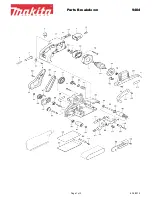
9 — English
OPERATION
WARNING:
Always wear safety goggles or safety glasses with side
shields when operating your sander. Failure to do so could
result in foreign objects being thrown into your eyes re-
sulting in possible serious injury. If the sanding operating
is dusty, also wear a face or dust mask.
SANDPAPER SELECTION
Selecting the correct size grit and type sandpaper is an
extremely important step in achieving a high quality sanded
finish. Aluminum oxide, silicon carbide, and other synthetic
abrasives are best for power sanding. Natural abrasives,
such as flint and garnet are too soft for economical use in
power sanding.
In general, coarse grit will remove the most material and finer
grit will produce the best finish in all sanding operations. The
condition of the surface to be sanded will determine which
grit will do the job. If the surface is rough, start with a coarse
grit and sand until the surface is uniform. Medium grit may
then be used to remove scratches left by the coarser grit and
finer grit used for finishing of the surface. Always continue
sanding with each grit until surface is uniform.
Sheet/Pad
Recommended Use
Heavy scrubbing pad
Paint and rust removal
Light scrubbing pad
Light scrubbing and cleaning
Polishing pad
Light cleaning and polishing
60-grit sandpaper
Coarse sanding
120-grit sandpaper
Light sanding
240-grit sandpaper
Finish sanding
ATTACHING HOOK-AND-LOOP SANDPAPER
See Figure 3, page 12.
Unplug the sander.
Align holes in hook-and-loop type sandpaper with holes in
pad, then carefully press fuzzy side of sandpaper against
pad as tightly as possible.
NOTE: Hook-and-loop type sandpaper can be reused for
the life of the sanding abrasive. It is recommended that
you keep the sandpaper backing pad clean to provide
for best adhesion. Clean occasionally by brushing lightly
with a small brush.
CAUTION:
Keep the cord away from the sanding pad and position
the cord so that it will not be caught on lumber, tools, or
other objects during sanding.
TURNING THE SANDER ON/OFF
See Figure 4, page 12.
Turn on the sander: Push the ON/OFF switch to the
left.
Turn off the sander: Push the ON/OFF switch to the
right.
CAUTION:
Be careful not to let your hand completely cover air
vents.
OPERATING THE SANDER
See Figures 5 - 6, page 12.
Secure the workpiece to prevent it from moving under
the sander.
WARNING:
Unsecured work could be thrown towards the operator
causing injury.
Place the sander on the workpiece so that all of the sand-
ing disc surface is in contact with the workpiece.
Turn the sander on and move it slowly over the
workpiece.
Hold the sander in front and away from you, keeping it clear
of the workpiece. Start sander and let the motor build to its
maximum speed, then gradually lower the sander onto the
workpiece. Move the sander slowly across the workpiece
using small circular motions.
See Figure 5.
Do not force. The weight of the unit supplies adequate
pressure, so let the sanding disc and sander do the work.
Applying additional pressure only slows the motor, rapidly
wears sanding disc and greatly reduces sander speed.
Excessive pressure will overload the motor causing possible
damage from motor overheating and can result in inferior
work. Any finish or resin on wood may soften from the
frictional heat. Do not allow sanding on one spot too long
as the sander’s rapid action may remove too much material,
making the surface uneven.
Extended periods of sanding may tend to overheat the motor.
If this occurs, turn sander off and wait until sanding disc
comes to a complete stop, then remove it from workpiece.
Remove your hand from vent area, remove sanding disc,
then with your hand removed from vent area, turn sander
on and run it free without a load to cool motor.
For detail sanding such as corners and crevices, use the tip
of the sanding pad with small back and forth motions, as
shown in figure 6.
Содержание CFS1501
Страница 32: ...12 Fig 2 Fig 3 Fig 1 Fig 4 Fig 5 Fig 6 Fig 7 Fig 8 ON marche ENCENDIDO off arr t aPAGADO...
Страница 33: ...13 Fig 9 Fig 10...
Страница 34: ...14 notes NOTAS...
Страница 35: ...15 notes NOTAS...










































